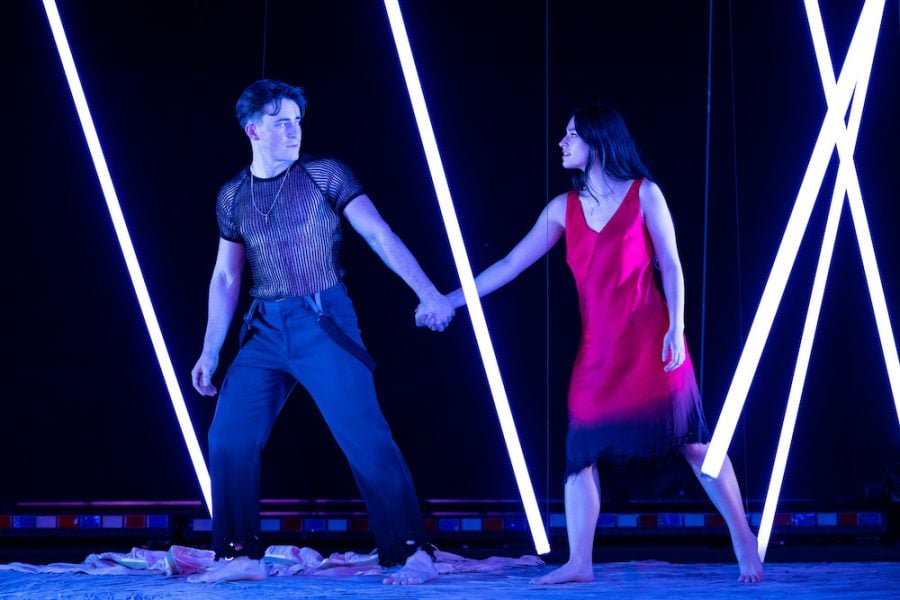‘Burn with desire’: ‘Blood Wedding’ ignites forgiveness and forbidden love at the Wirtz Center
Photo courtesy of Justin Barbin
“Blood Wedding” brings to life forbidden love, loss and the resilience of women through multilingual performance.
February 8, 2023
This piece contains spoilers.
Exploring unlived lives and breaking societal bonds, the Wirtz Center for the Performing Arts’ production of “Blood Wedding” illuminated the hardships of forgiveness, love and healing through multilingual communication. The Spanish tragedy, translated from Federico García Lorca’s original stage play, brought forth the destruction of unfulfilled desires while emphasizing the actions needed to forge a new path forward.
Picked from a well-worn book of plays kept from his undergraduate years, director and MFA directing candidate at Northwestern Ismael Lara, Jr. felt a “wild, intense and ferocious” attraction to the play’s themes of forbidden love and coping with loss.
“The soul of the play really speaks to people wanting to break free from the structure of society and follow their hearts,” Lara said.
“Blood Wedding” tells the story of two lovers kept apart by societal obligations in 20th century Spain: a bride from a wealthy family set to marry a well-endowed groom, and Leonardo, a rancher without a fortune to his name married to the bride’s cousin. Unable to deny their attraction, the bride and Leonardo take to the forest to escape their marital duties as the status quo erupts. The resulting violence forces change on the town, now saddled with enormous grief.
Beyond the element of romance, Communication junior Sophia Talwalkar, who plays both Death and the Maid, said the show is an ode to female resilience and the burden women often bear in the aftermath of destruction. In the final moments of the show, only women dressed in black remain on the dirt-dusted stage. Their decision to bury their grievances over the death of family and lovers ends the cycle of violence.
“Women have historically been seen as the healers, but the play also speaks to women’s strength,” Talwalkar said. “They have to build back their town and build back the relationships that have been broken and heal each other.”
To emphasize this theme of feminine strength, Lara included moments of “seeing one another” — unscripted eye contact between the female characters — as a symbol of both their camaraderie and shared obligation to withstand the storm.
Though told through the perspective of a heterosexual couple, Lara said “Blood Wedding” was influenced by Lorca’s experience as a queer man living in the 1920s. Denied free expression, Lorca was no stranger to the struggles of individuals longing to escape their societal duties. Regardless, “Blood Wedding” captured the universal agony of a yearning heart.
“I want to believe that (Lorca) wrote this play to liberate the queer community at the time and to show what it’s like to be forbidden to love somebody and to be forced to love,” Talwalkar said.
Choreographer Emily Ann Brooks (Communication ʼ22) worked to build a movement lexicon to physically manifest the characters’ desires. Writhing bodies, labored breathing and Leonardo and the Bride’s inability to stay apart gave power to the couple’s internal struggle between lines of dialogue.
Brooks said the movement-based prologue she and Lara added to Wirtz’s adaptation was integral in introducing the play’s enduring dynamics of forbidden feelings. The opening minutes keyed the audience into the Bride and Leonardo’s history, while establishing the gestures used in later scenes.
“We have this vocabulary to highlight the ways that the Bride and Leonardo are different from their community,” Brooks said. “They’re haunted by this moment of freedom from the constraints of the world around them, and they crave that again.”
The set itself was designed to mirror the couple’s liberation throughout the course of the play, according to Lara. A boxed-in structure containing normal life opens into a dance floor during the wedding reception when the lovers reunite before shattering completely into a light-filled forest when they give into their true emotions.
As part of his effort to increase Latine representation and the use of Spanish on stage, Lara said the cast was given special permission from the translator to reevaluate some of Lorca’s original text. The interwoven usage of Spanish and English helped create a production more malleable to the interpretations of the ensemble, Lara said.
Lara said having a majority Latine cast further added to the expression of identity through language and fostered an environment of collaboration throughout the rehearsal process.
“Incorporating Lorca’s original text gave the actors who did speak the language the freedom to choose what they felt was important to say in Spanish and in English,” Lara said.
“Blood Wedding” embodies how the characters grapple with pain and frustration, and put truth behind Leonardo’s head to the Bride: “to burn with desire and keep quiet about it is the greatest punishment we can bring on ourselves.”
The show emboldens audiences to chase after desire and live authentically. Despite the hurt they cause, Lara said Leonardo and the Bride remain redeemable characters for their willingness to take a chance on their feelings for the sake of love and self-preservation — a lesson worth internalizing.
“We can’t continue moving through life suppressing what we want,” Lara said. “We have to talk about it, we have to express it, we have to go after it because if we don’t, we’re actually doing harm to ourselves.”
Email: [email protected]
Twitter: @NixieStrazza
Related Stories:
— “In His Hands” explores queer love, trauma and faith at the Wallis Theater
— Cast of NU ‘In the Heights’ celebrate their identities in an immersive musical
— ‘With specificity, there’s universality:’ Destinos uplifts and amplifies Latino voices












